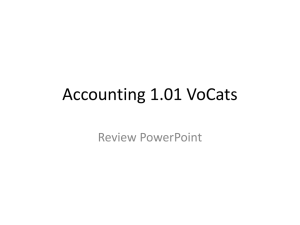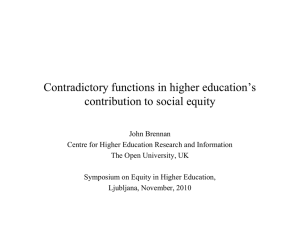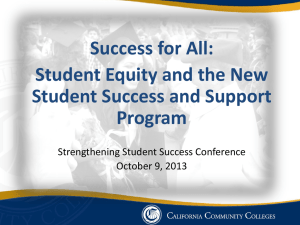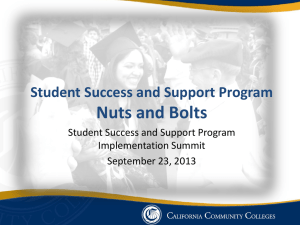Student Equity Background - California Community Colleges
advertisement
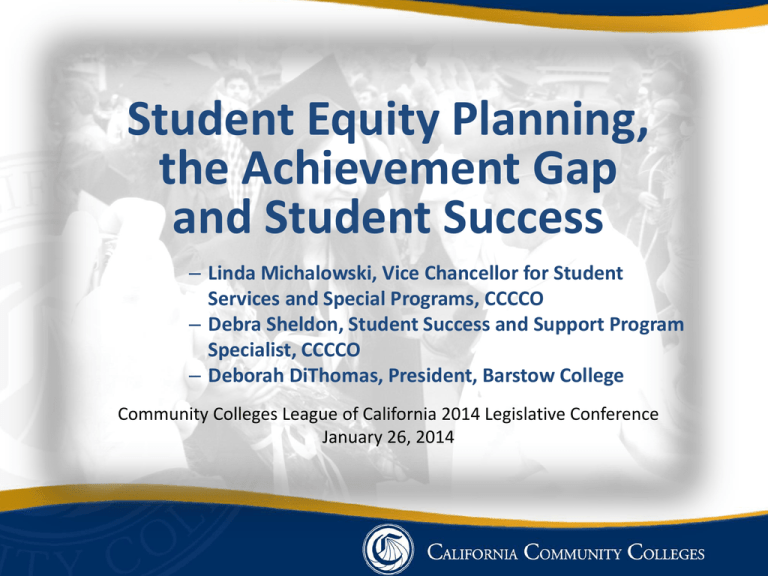
Student Equity Planning, the Achievement Gap and Student Success – Linda Michalowski, Vice Chancellor for Student Services and Special Programs, CCCCO – Debra Sheldon, Student Success and Support Program Specialist, CCCCO – Deborah DiThomas, President, Barstow College Community Colleges League of California 2014 Legislative Conference January 26, 2014 Why Student Equity ? From the Academic Senate’s 1992-93 “Guidelines for Developing a Student Equity Plan” ... It matters to our future and to our students… California will not be a pleasant place to live for any of us if a permanent underclass largely composed of those from ethnic minorities has little stake in society and little hope for the future. We can now easily see how economically weak and socially explosive such a society would be. If community colleges work successfully in the effort to increase rates of student success, the State just might have a better future. If we fail, it is hard to imagine who else can make up for our failure. Student Equity Planning in the CCC’s • Background • • • • • Origins and purpose of CCC student equity planning Requirements Resources Local College Experiences Your Input Student Equity Background 1992 — in response to legislation the BOG adopted a student equity policy to ensure that historically underrepresented groups have equal opportunity for access, success, and transfer; requiring districts to develop, implement, & evaluate a student equity plan. 1996, the BOG amended its policy to establish the adoption of a student equity plan as a minimum standard for receipt of state funding. Student Equity Background 2002 — BOG adopted recommendations of Task Force on Equity and Diversity for title 5 regulations requiring colleges to develop Student Equity Plan 2003 — Chancellor's Office provided guidelines to colleges for development of the plan 2005 — Chancellor's Office asked colleges to update/complete Student Equity plan Student Equity Background 2008-09 to 2012-13 economic downturn resulted in: • State budget cuts • Suspension of many regulatory requirements • Categorical program flexibility 2011— Student Success Task Force established 2012— Student Success Act of 2012 (SB1456) and reaffirmation of student equity 2013—Student Equity Workgroup convened Student Equity Background 2014—Governor proposes to include an additional $100 million of SSSP funding to • “close achievement gaps in access and success in underrepresented student groups, as identified in local student equity plans.” • if approved, current budget bill, SB 851 (Leon), language specifies that the Chancellor’s Office shall allocate funds to districts “in a manner that ensures districts with a greater proportion or number of students who are highneed, as determined by the Chancellor’s Office, receive greater resources to provide services to these students.” Student Equity Background Governor’s new proposal for student equity SSSP funding are based upon similar concepts found in the new K-12 Local Control Funding Formula: • Provide more money to districts where “the need and the challenge is greatest.” • Give local districts more authority to decide how to spend the money, and hold them accountable for the results Funding for Student Equity is a proposal and is subject to change. What is Student Equity Planning? Success Indicators • • • • • • Planning Steps Access • Course Completion • ESL and Basic Skills Completion • Degree and Certificate • Completion Transfer • Student Success and Support • Services: The effect of mandatory participation of new students in • SSSP services the other indicators Establish Committee Conduct Research Develop Goals and Outcomes Develop Actions to Address and Monitor Disparities Implement Actions Coordinate with the SSS Program Plan (SB 1456) Review progress and Make Needed Changes *Disaggregate data by student demographics Student Equity Requirements Required Populations to be addressed: • American Indians or Alaskan natives • Asians or Pacific Islanders • Blacks • Hispanics • Whites • Men • Women • Persons with disabilities. Student Equity Recommendations • • Integrate Student Equity planning into college and district wide planning efforts: Accreditation Educational master planning Program review Student Success & Support Program Plan Basic Skills Plan Adopt a holistic approach to planning, budgeting, and delivery of services to support equity in student access and success Student Equity Requirements • Draft Student Equity Plan Timeline: Planning timeframe of 3-5 years Annual update Initial Plan Due October 17, 2014 Student Equity Planning Resources Chancellor’s Office Student Equity web page: http://extranet.cccco.edu/Divisions/StudentServ ices/StudentEquity.aspx Student Equity Fact Sheet Draft Revised Student Equity Plan Template Guides for Measuring Disproportionate Impact in Equity Plans Student Equity Planning Resources • Academic Senate for California Community Colleges: http://asccc.org (includes papers related to equity and basic skills) • California Community Colleges Chancellor’s Office: http://scorecard.cccco.edu http://datamart.cccco.edu Includes basic skills, retention/success rate, etc. http://extranet.cccco.edu/Divisions/StudentServices/Matriculation/Resources.aspx Includes the Disproportionate Impact Guide developed by the RP Group • Disproportionate Impact Webinar: Coming soon! Action Planning: Questions for Consideration • How are you monitoring disproportionate impact? • Who is or needs to be involved in this effort? • How often should available data be examined to note progress or a need for additional changes? • Which groups of students are likely to be affected and/or targeted? • What kind of training or professional development is needed? 15 Guiding Questions ● Where is disproportionate impact an issue? ● What strategies and approaches have colleges successfully implemented to mitigate it? ● What data can be accessed to explore the issue? ● What relevant analyses can be conducted to monitor changes in disproportionate impact? ● How can colleges use this information for action planning and improvement? 16 Local College Experiences • Deborah DiThomas, President, Bartsow College – Former VP of Student Services at Norco College – Former Vice Chancellor of Student Services at Riverside Community College District – Former VP of Student Services and Dean of Matriculation at Riverside College 17 Student Equity Planning “Student Equity: The task is not simply to produce a plan, but to make a difference.” Mike Anker From the Academic Senate’s 1992-93 “Guidelines for Developing a Student Equity Plan” ... It matters to our future and to our students…California will not be a pleasant place to live for any of us if a permanent underclass largely composed of those from ethnic minorities has little stake in society and little hope for the future. We can now easily see how economically weak and socially explosive such a society would be. If community colleges work successfully in the effort to increase rates of student success, the State just might have a better future. If we fail, it is hard to imagine who else can make up for our failure. What Did We Discover through our Student Equity Plan at RCCD? Student Equity Plan Major Research Findings •Access OK ~ Ethnically, RCCD’s student population mirrors the service area ~ •African American students had the lowest levels of course completion rates (61%). •For transfer courses only, all ethnicities of student except for Hispanic, Native American, and African American students rose to the mid-70 in percent by 2002-03 with African American performing the lowest (65%). •The lowest large ethnic group reporting course completion in all courses was Black males (57.9%). Student Equity Plan Major Research Findings • Hispanic and African American had the lowest success rates (63% and 75% respectively) in transferable English. • Percentages of students who successfully passed through the entire English sequence ~ White-33%; African American 28%; Hispanic—30% • Asian students passed nontransferable math 20 percentage points higher than African American students (65% to 45%, respectively). • Those who continued to transferable college math 9% passed the course. (Asians passed at 13% ~ African Americans 6%. • African-Americans were least successful in completing college level English. What did we do with these findings? • Gathered dedicated professionals to figure out how to address the need • Researched other colleges’ programs • Provided funding • Staff Development • Continued support • Process for evaluation Major Goal of Plan: A “Student Equity Implementation Task Force,” under the direction of the Academic Senate and consisting of representation from administration, faculty, staff, students and community members was formed during spring of 2005. • Is responsible for oversight of implementation of all plan activities. • Consults with Office of Institutional Research to develop and implement all Equity Plan evaluation work to ensure that the research will be in keeping with the spirit of the document. • A sub-committee to address the needs of the African American Student population was formed on each campus. Student Equity Funding 05 ~ 06: • $2,000 from AVC’s Contingency Fund • $3,000 per campus from Matriculation • Participated in Budget Process for 06 – 07 06 ~ 07: • $2,000 from AVC’s Contingency Fund • $5,000 per campus from Matriculation (Small stipend per campus to pay for faculty leadership.) • $5,000 per campus from General Fund (actual Budget Line Item for Student Equity!) Student Equity Policy/Procedure AP 5300 includes the following: • The Plan will be updated and sent to the State Chancellor’s Office every five (5) years. • The Student Equity Plan has been developed, maintained, and updated under the supervision of the Academic Senate Subcommittee for Student Equity. The Plan is on file, and can be viewed, in the Office of the Chief Student Services Officer on each campus. • It can also be viewed online at: http://www.rccdfaculty.net/pages/Evidence/Student%20Service s/Final%20Student%20E quity%20Plan% Observable Outcomes (SLO’s ) • • • • District Student Equity Team Three Campus Student Equity Teams Three Campus African American Success Initiatives General Fund and Categorical Money Devoted to Student Equity Efforts • Initial Draft of Evaluation Plan • Rice Diversity Award Recipients Your Input • What can trustees and college presidents do to support student equity on their campuses? • What best practices or planning strategies should be highlighted at the state level to help colleges implement student equity? • Governor’s proposal: What factors should be included in developing a funding formula and/or funding distribution mechanism? 28 Thank you.


